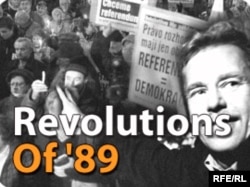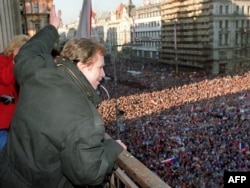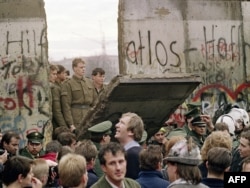It was a tumultuous year in world history -- a year that saw the fall of the Berlin Wall and the collapse of communism across much of Eastern Europe.
The revolutions of 1989 -- some peaceful and some violent, some popular revolts and some orchestrated within the Communist Party leadership -- cast aside Europe's Cold War dictators, paving the way for democracy and the free-market reforms of the 1990s.
It was June 12, 1987, when U.S. President Ronald Reagan stood at Berlin's Brandenburg Gate and challenged Soviet General Secretary Mikhail Gorbachev to "tear down" the wall dividing the city between the Soviet East and the democratic West.
Gorbachev that same month introduced the political and economic reforms of perestroika in an attempt to rejuvenate the Communist Party. East European leaders learned they could no longer depend on Soviet tanks to suppress their political opponents.
Looking back 20 years later, Gorbachev tells RFE/RL he has no regrets about the decisions he and the Soviet leadership made at that time. He says his decisions were made in the interests Russia, the Germans, Europe, and the whole world.
Gorbachev says that people in Russia ask him how he could have given up Soviet control. "But what did I give up? When I answer that way, people don't know how to answer," he says.
"What did I give up? Poland to the Poles. Czechoslovakia to the Czechs and the Slovaks. And so on. To whom did [those lands] belong? 'No!' people say -- they still don't agree. But [letting the Soviet bloc go] made life easier for our country. In that sense, how Russia acted shouldn't be the subject of debate."
The Wall Came Tumbling Down
East Germany's communist regime started to falter in May 1989 when Hungary created a hole in the Iron Curtain, eventually allowing tens of thousands of East Germans to pass to the West through Austria. Thousands took refuge in West German embassies in Budapest, Prague, and Warsaw.
Many see the turning point of East Germany's "Peaceful Revolution" as October 9, 1989. That's when East German police abandoned plans to forcibly disperse a massive, peaceful demonstration in Leipzig.
Gorbachev had just visited East Germany's hard-line communist leader, Erich Honecker, to push him to accept perestroika reforms. From then on, with daily protests of more than 1 million people in Leipzig and East Berlin, Honecker's days in office were numbered. He resigned on October 18, claiming poor health.
Egon Krenz took over from Honecker. But he was ineffective against the mass protests, and could not hold back East German emigration to the West through Czechoslovakia.
On November 9, the East German government decided to open its borders to West Germany and West Berlin. The announcement was made by Gunter Schabowski, a member of the East German Politburo.
When asked by a Western journalist when the regulation would take effect, Schabowski quickly scanned the legal document and said: "This has become effective, to my knowledge. It's now. Immediately. Without delay."
Schabowski's answer was premature. The law said East Germans were required to apply for a special visa and wait at least one day before they could go West.
Without knowing about the requirement to get a visa from their own government, tens of thousands of East Berliners flocked to border crossings and discovered unprepared police who would not let them through. As the size and anger of the crowds increased, some border police chiefs decided to open the gets and let people through.
The Berlin Wall had fallen. Within a year, East and West Germany would be reunified.
On the 20th anniversary of the dramatic fall of communism across Eastern Europe, RFE/RL interviewed some of the key players -- former Soviet President Mikhail Gorbachev and former Czech President Vaclav Havel -- for a look back at the revolutions of 1989.
Shock Waves And Dominoes
The collapse of the Berlin Wall sent shock waves through the rest of the Eastern bloc -- with other communist regimes falling, one by one, like dominos.
Todor Zhivkov, Bulgaria's dictator for 35 years, resigned the day after the checkpoints at the Berlin Wall were opened. It was a "palace revolution" by the reformist wing of the Bulgarian Communist Party that brought him down.
Foreign Minister Petar Mladenov and the reformist technocrat Andrei Lukanov gained the upper hand on the party's Central Committee. They dismantled the party as an instrument of Zhivkov's personal power and renamed it the Bulgarian Socialist Party.
Velvet Revolution
In Czechoslovakia, the opposition lagged behind some of its neighbors on challenging the communist system. But once change began in Prague, the Velvet Revolution quickly swept away the authoritarian system.
The Civic Forum was established the next day to coordinate opposition activities. Many members were signatories of Charter 77, a petition endorsed by dissident intellectuals in 1977 that challenged the communist regime's record on human rights.
The Civic Forum's chief spokesman was Vaclav Havel, a dissident playwright and Charter 77 signatory whose election as president in December 1989 would cap the Velvet Revolution. Havel says that the opposition had been waiting for a key event to galvanize mass protests:
"What was clear, however -- and I've spoken or written about this before -- was that sooner or later a snowball would start rolling and turn into an avalanche," Havel tells RFE/RL.
"No one knew what that snowball would be and when it would happen precisely. We weren't soothsayers. But it was clear that sooner or later it had to happen."
Police violence against the students in Prague provided that spark, leading to a series of nationwide protests that grew in size every day.
On November 27, the Civic Forum called a general strike. Enormous crowds gathered in Prague, expressing disdain for Communist Party leader Milos Jakes by chanting rally cries like "Jakes to the trash." Two days later, Jakes's government fell. The relatively peaceful transition earned Czechoslovakia's uprising its historic "velvet" nickname.
Blood And Revolt In Romania
In contrast to the Velvet Revolution, events in Romania turned violent. More than 1,000 people were killed in clashes with security forces before dictator Nicolae Ceausescu, the last remaining old-style communist leader in Eastern Europe, was ousted and executed.
Over five days in mid-December, protesters in Timisoara were brutally repressed by police and military forces. RFE/RL journalist Emil Hurezeanu described the chaos, gunfire, and riots in a Romanian broadcast on December 18, 1989:
Ceausescu called a rally on December 21 in Bucharest to denounce the Timisoara uprising. But he badly misread the mood of the Romanian people -- who were tired of poverty and shortages, and eager for change following the collapse of the Berlin Wall and demise of communist regimes elsewhere in Eastern Europe.
In the middle of Ceausescu's speech, which was being broadcast live across Romania on state television, a disturbance broke out in the crowd. Before state censors could cut the broadcast, Romanians saw Ceausescu's uncomprehending reaction to the start of a popular revolt in Bucharest.
After shouting, "Stay quiet and stand in your place" at the crowd, Ceausescu was hustled by henchmen inside the Central Committee building, where he and his wife Elena spent the night.
The rally degenerated into chaos, and mutated into an anticommunist revolt that continued in the capital the rest of the day. In the evening, as demonstrators assembled at Bucharest's nearby University Square, dozens were shot dead by security forces. Hundreds were arrested and beaten.
By the next morning, the revolt had spread to all major cities in Romania. When thousands of workers marched on the Central Committee building in Bucharest, Ceausescu and his wife fled in a helicopter.
The revolution received a boost when Romania's military forces switched sides. Ceausescu and his wife, alone after abandoning their helicopter near Targoviste, were turned over to the army by a driver who had picked them up as hitchhikers.
They were convicted in a show trial by a military court on charges ranging from illegally gathering wealth to the deaths of thousands of people before and during the revolution. Sentenced to death, they were executed by firing squad the same day -- Christmas Day, December 25, 1989.
The collapse of communism would have costs for the people of Eastern Europe. In some areas, notions of national identity would be rekindled -- contributing to the disintegration of federal Yugoslavia and the Soviet Union in 1991, and leading to violent struggles from the Balkans to the Caucasus and Central Asia, the ramifications of which are felt to this day.
The revolutions of 1989 -- some peaceful and some violent, some popular revolts and some orchestrated within the Communist Party leadership -- cast aside Europe's Cold War dictators, paving the way for democracy and the free-market reforms of the 1990s.
It was June 12, 1987, when U.S. President Ronald Reagan stood at Berlin's Brandenburg Gate and challenged Soviet General Secretary Mikhail Gorbachev to "tear down" the wall dividing the city between the Soviet East and the democratic West.
Gorbachev that same month introduced the political and economic reforms of perestroika in an attempt to rejuvenate the Communist Party. East European leaders learned they could no longer depend on Soviet tanks to suppress their political opponents.
Looking back 20 years later, Gorbachev tells RFE/RL he has no regrets about the decisions he and the Soviet leadership made at that time. He says his decisions were made in the interests Russia, the Germans, Europe, and the whole world.
Gorbachev says that people in Russia ask him how he could have given up Soviet control. "But what did I give up? When I answer that way, people don't know how to answer," he says.
"What did I give up? Poland to the Poles. Czechoslovakia to the Czechs and the Slovaks. And so on. To whom did [those lands] belong? 'No!' people say -- they still don't agree. But [letting the Soviet bloc go] made life easier for our country. In that sense, how Russia acted shouldn't be the subject of debate."
The Wall Came Tumbling Down
East Germany's communist regime started to falter in May 1989 when Hungary created a hole in the Iron Curtain, eventually allowing tens of thousands of East Germans to pass to the West through Austria. Thousands took refuge in West German embassies in Budapest, Prague, and Warsaw.
West Berliners watch people trying to demolish a section of the Berlin Wall in near Potsdamer Square on November 11, 1989.
The flood of migrants accelerated after September 10, 1989, when Hungary granted official permission for East German refugees to exit to the West. Czechoslovakia and Poland passed comparable agreements in October 1989.Many see the turning point of East Germany's "Peaceful Revolution" as October 9, 1989. That's when East German police abandoned plans to forcibly disperse a massive, peaceful demonstration in Leipzig.
Gorbachev had just visited East Germany's hard-line communist leader, Erich Honecker, to push him to accept perestroika reforms. From then on, with daily protests of more than 1 million people in Leipzig and East Berlin, Honecker's days in office were numbered. He resigned on October 18, claiming poor health.
Egon Krenz took over from Honecker. But he was ineffective against the mass protests, and could not hold back East German emigration to the West through Czechoslovakia.
On November 9, the East German government decided to open its borders to West Germany and West Berlin. The announcement was made by Gunter Schabowski, a member of the East German Politburo.
When asked by a Western journalist when the regulation would take effect, Schabowski quickly scanned the legal document and said: "This has become effective, to my knowledge. It's now. Immediately. Without delay."
Schabowski's answer was premature. The law said East Germans were required to apply for a special visa and wait at least one day before they could go West.
Without knowing about the requirement to get a visa from their own government, tens of thousands of East Berliners flocked to border crossings and discovered unprepared police who would not let them through. As the size and anger of the crowds increased, some border police chiefs decided to open the gets and let people through.
The Berlin Wall had fallen. Within a year, East and West Germany would be reunified.
On the 20th anniversary of the dramatic fall of communism across Eastern Europe, RFE/RL interviewed some of the key players -- former Soviet President Mikhail Gorbachev and former Czech President Vaclav Havel -- for a look back at the revolutions of 1989.
Shock Waves And Dominoes
The collapse of the Berlin Wall sent shock waves through the rest of the Eastern bloc -- with other communist regimes falling, one by one, like dominos.
Todor Zhivkov, Bulgaria's dictator for 35 years, resigned the day after the checkpoints at the Berlin Wall were opened. It was a "palace revolution" by the reformist wing of the Bulgarian Communist Party that brought him down.
Foreign Minister Petar Mladenov and the reformist technocrat Andrei Lukanov gained the upper hand on the party's Central Committee. They dismantled the party as an instrument of Zhivkov's personal power and renamed it the Bulgarian Socialist Party.
Velvet Revolution
In Czechoslovakia, the opposition lagged behind some of its neighbors on challenging the communist system. But once change began in Prague, the Velvet Revolution quickly swept away the authoritarian system.
Vaclav Havel waves to a crowd of thousands of demonstrators on Wenceslas Square in Prague on December 10, 1989.
The opposition was crystallized on November 17 when state security services violently suppressed a student demonstration in Prague.The Civic Forum was established the next day to coordinate opposition activities. Many members were signatories of Charter 77, a petition endorsed by dissident intellectuals in 1977 that challenged the communist regime's record on human rights.
The Civic Forum's chief spokesman was Vaclav Havel, a dissident playwright and Charter 77 signatory whose election as president in December 1989 would cap the Velvet Revolution. Havel says that the opposition had been waiting for a key event to galvanize mass protests:
"What was clear, however -- and I've spoken or written about this before -- was that sooner or later a snowball would start rolling and turn into an avalanche," Havel tells RFE/RL.
"No one knew what that snowball would be and when it would happen precisely. We weren't soothsayers. But it was clear that sooner or later it had to happen."
Police violence against the students in Prague provided that spark, leading to a series of nationwide protests that grew in size every day.
On November 27, the Civic Forum called a general strike. Enormous crowds gathered in Prague, expressing disdain for Communist Party leader Milos Jakes by chanting rally cries like "Jakes to the trash." Two days later, Jakes's government fell. The relatively peaceful transition earned Czechoslovakia's uprising its historic "velvet" nickname.
Blood And Revolt In Romania
In contrast to the Velvet Revolution, events in Romania turned violent. More than 1,000 people were killed in clashes with security forces before dictator Nicolae Ceausescu, the last remaining old-style communist leader in Eastern Europe, was ousted and executed.
Over five days in mid-December, protesters in Timisoara were brutally repressed by police and military forces. RFE/RL journalist Emil Hurezeanu described the chaos, gunfire, and riots in a Romanian broadcast on December 18, 1989:
Nicolae Ceausescu (right) delivers his last public speech from the balcony of the Romanian Communist Party Headquarters in Bucharest.
"At the beginning there were just several hundred people, then thousands, and according to some reports even tens of thousands," Hurezeanu reported. "The city of Timisoara has been blocked since Saturday [December 16]. The events continued during the second day, on Sunday, when demonstrations escalated."Ceausescu called a rally on December 21 in Bucharest to denounce the Timisoara uprising. But he badly misread the mood of the Romanian people -- who were tired of poverty and shortages, and eager for change following the collapse of the Berlin Wall and demise of communist regimes elsewhere in Eastern Europe.
In the middle of Ceausescu's speech, which was being broadcast live across Romania on state television, a disturbance broke out in the crowd. Before state censors could cut the broadcast, Romanians saw Ceausescu's uncomprehending reaction to the start of a popular revolt in Bucharest.
After shouting, "Stay quiet and stand in your place" at the crowd, Ceausescu was hustled by henchmen inside the Central Committee building, where he and his wife Elena spent the night.
The rally degenerated into chaos, and mutated into an anticommunist revolt that continued in the capital the rest of the day. In the evening, as demonstrators assembled at Bucharest's nearby University Square, dozens were shot dead by security forces. Hundreds were arrested and beaten.
By the next morning, the revolt had spread to all major cities in Romania. When thousands of workers marched on the Central Committee building in Bucharest, Ceausescu and his wife fled in a helicopter.
The revolution received a boost when Romania's military forces switched sides. Ceausescu and his wife, alone after abandoning their helicopter near Targoviste, were turned over to the army by a driver who had picked them up as hitchhikers.
They were convicted in a show trial by a military court on charges ranging from illegally gathering wealth to the deaths of thousands of people before and during the revolution. Sentenced to death, they were executed by firing squad the same day -- Christmas Day, December 25, 1989.
The collapse of communism would have costs for the people of Eastern Europe. In some areas, notions of national identity would be rekindled -- contributing to the disintegration of federal Yugoslavia and the Soviet Union in 1991, and leading to violent struggles from the Balkans to the Caucasus and Central Asia, the ramifications of which are felt to this day.
Revolutions Of '89
When The Wall Came Down
























